Report on Pitching and Negotiation Skills for NISA Company
VerifiedAdded on 2022/11/29
|16
|3975
|110
Report
AI Summary
This report delves into the critical aspects of pitching and negotiation skills, using NISA as a case study. It begins by defining negotiation, its importance, and the key stakeholders involved. The report then analyzes the steps required for effective negotiation, including preparation, information exchange, clarification, bargaining, and conclusion. It also examines the Request for Proposal (RFP) process, detailing the necessary documentation and steps involved. Furthermore, the report explores contractual processes, documentation management, and the principles for achieving a sustainable competitive edge in pitches. It also covers potential outcomes of pitches within companies, evaluating ways to maximize the chances of a successful pitch, and recommendations for post-pitch obligations. The report is a comprehensive guide to understanding and improving pitching and negotiation skills in a business context.
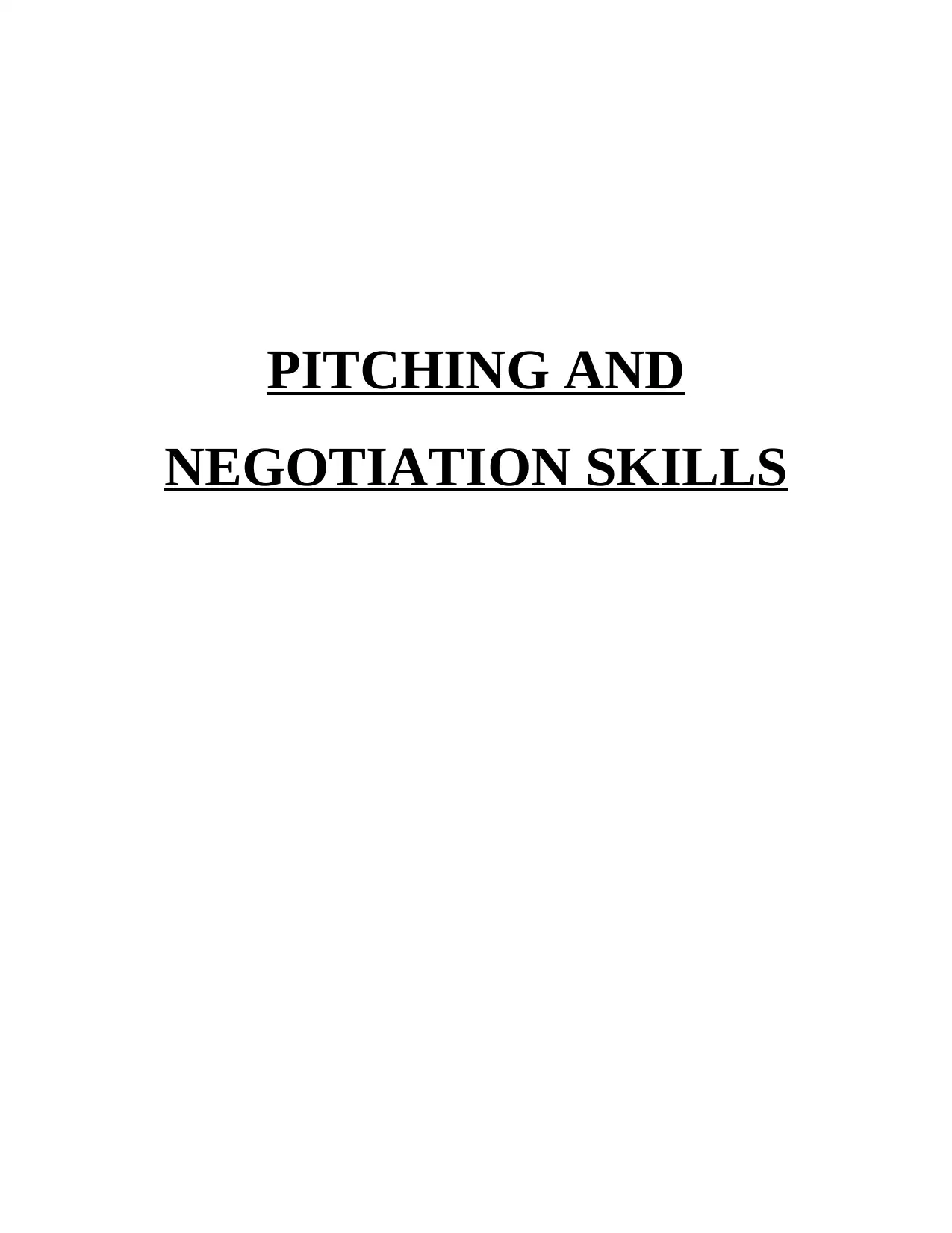
PITCHING AND
NEGOTIATION SKILLS
NEGOTIATION SKILLS
Paraphrase This Document
Need a fresh take? Get an instant paraphrase of this document with our AI Paraphraser
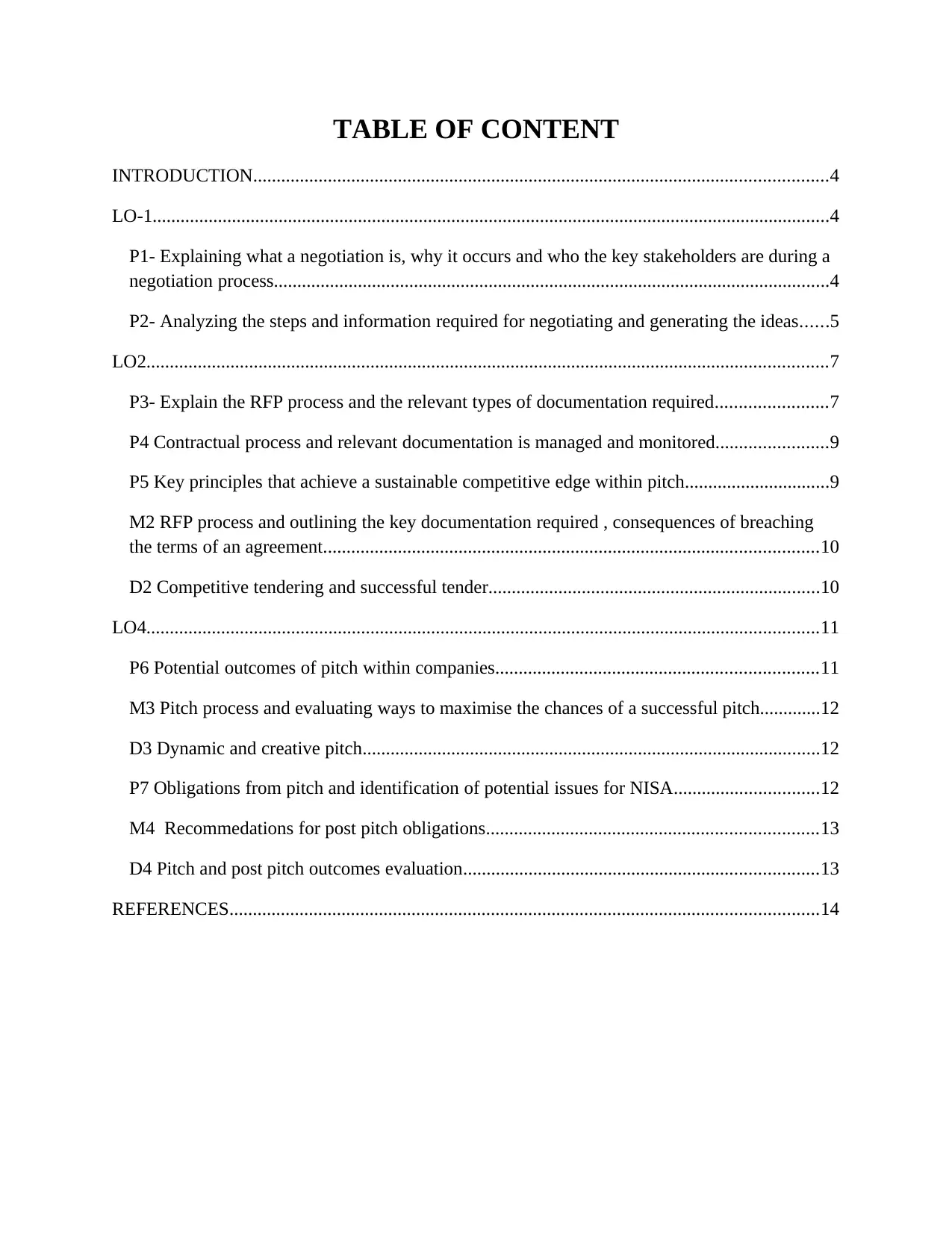
TABLE OF CONTENT
INTRODUCTION...........................................................................................................................4
LO-1.................................................................................................................................................4
P1- Explaining what a negotiation is, why it occurs and who the key stakeholders are during a
negotiation process.......................................................................................................................4
P2- Analyzing the steps and information required for negotiating and generating the ideas......5
LO2..................................................................................................................................................7
P3- Explain the RFP process and the relevant types of documentation required........................7
P4 Contractual process and relevant documentation is managed and monitored........................9
P5 Key principles that achieve a sustainable competitive edge within pitch...............................9
M2 RFP process and outlining the key documentation required , consequences of breaching
the terms of an agreement..........................................................................................................10
D2 Competitive tendering and successful tender.......................................................................10
LO4................................................................................................................................................11
P6 Potential outcomes of pitch within companies.....................................................................11
M3 Pitch process and evaluating ways to maximise the chances of a successful pitch.............12
D3 Dynamic and creative pitch..................................................................................................12
P7 Obligations from pitch and identification of potential issues for NISA...............................12
M4 Recommedations for post pitch obligations.......................................................................13
D4 Pitch and post pitch outcomes evaluation............................................................................13
REFERENCES..............................................................................................................................14
INTRODUCTION...........................................................................................................................4
LO-1.................................................................................................................................................4
P1- Explaining what a negotiation is, why it occurs and who the key stakeholders are during a
negotiation process.......................................................................................................................4
P2- Analyzing the steps and information required for negotiating and generating the ideas......5
LO2..................................................................................................................................................7
P3- Explain the RFP process and the relevant types of documentation required........................7
P4 Contractual process and relevant documentation is managed and monitored........................9
P5 Key principles that achieve a sustainable competitive edge within pitch...............................9
M2 RFP process and outlining the key documentation required , consequences of breaching
the terms of an agreement..........................................................................................................10
D2 Competitive tendering and successful tender.......................................................................10
LO4................................................................................................................................................11
P6 Potential outcomes of pitch within companies.....................................................................11
M3 Pitch process and evaluating ways to maximise the chances of a successful pitch.............12
D3 Dynamic and creative pitch..................................................................................................12
P7 Obligations from pitch and identification of potential issues for NISA...............................12
M4 Recommedations for post pitch obligations.......................................................................13
D4 Pitch and post pitch outcomes evaluation............................................................................13
REFERENCES..............................................................................................................................14

⊘ This is a preview!⊘
Do you want full access?
Subscribe today to unlock all pages.

Trusted by 1+ million students worldwide
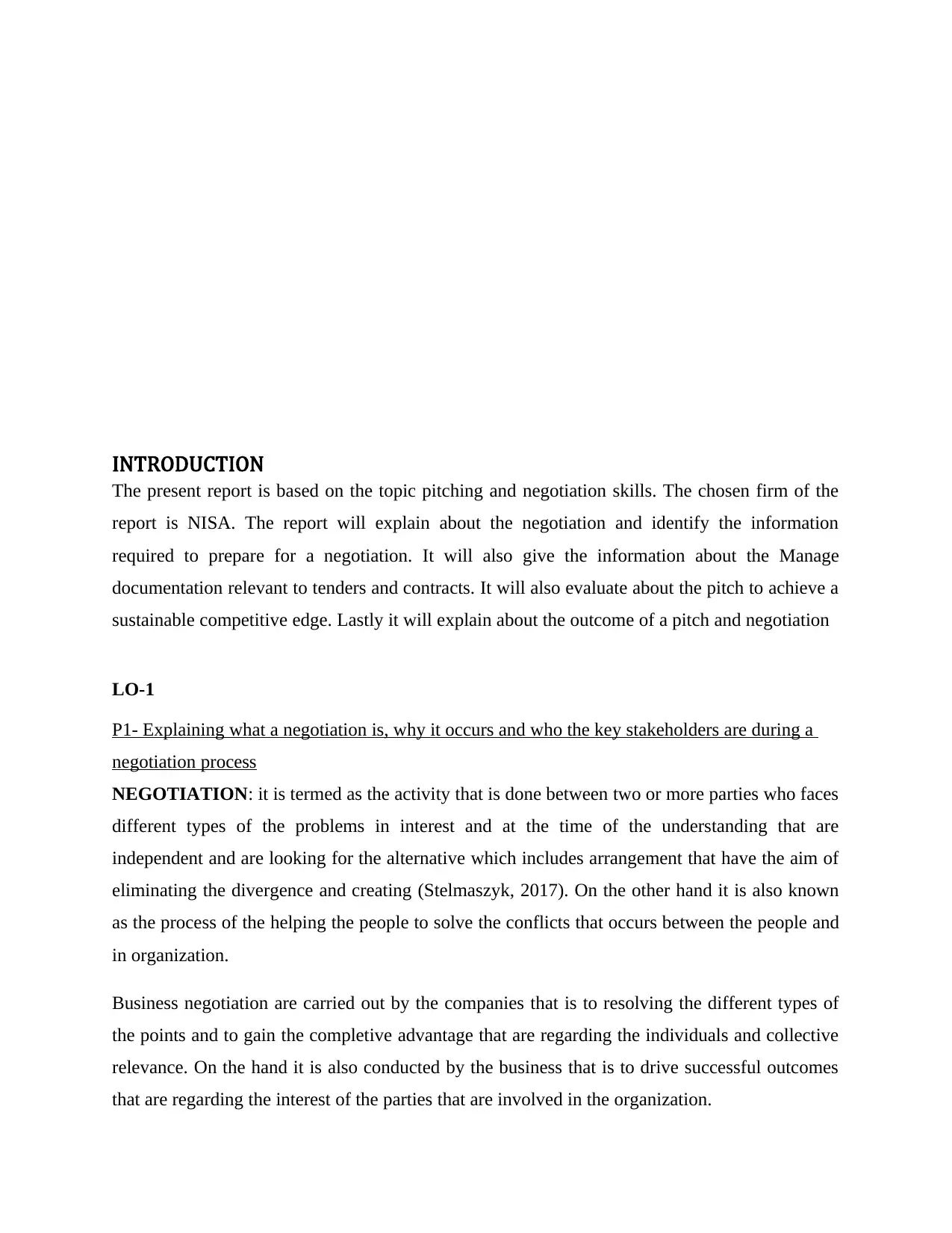
INTRODUCTION
The present report is based on the topic pitching and negotiation skills. The chosen firm of the
report is NISA. The report will explain about the negotiation and identify the information
required to prepare for a negotiation. It will also give the information about the Manage
documentation relevant to tenders and contracts. It will also evaluate about the pitch to achieve a
sustainable competitive edge. Lastly it will explain about the outcome of a pitch and negotiation
LO-1
P1- Explaining what a negotiation is, why it occurs and who the key stakeholders are during a
negotiation process
NEGOTIATION: it is termed as the activity that is done between two or more parties who faces
different types of the problems in interest and at the time of the understanding that are
independent and are looking for the alternative which includes arrangement that have the aim of
eliminating the divergence and creating (Stelmaszyk, 2017). On the other hand it is also known
as the process of the helping the people to solve the conflicts that occurs between the people and
in organization.
Business negotiation are carried out by the companies that is to resolving the different types of
the points and to gain the completive advantage that are regarding the individuals and collective
relevance. On the hand it is also conducted by the business that is to drive successful outcomes
that are regarding the interest of the parties that are involved in the organization.
The present report is based on the topic pitching and negotiation skills. The chosen firm of the
report is NISA. The report will explain about the negotiation and identify the information
required to prepare for a negotiation. It will also give the information about the Manage
documentation relevant to tenders and contracts. It will also evaluate about the pitch to achieve a
sustainable competitive edge. Lastly it will explain about the outcome of a pitch and negotiation
LO-1
P1- Explaining what a negotiation is, why it occurs and who the key stakeholders are during a
negotiation process
NEGOTIATION: it is termed as the activity that is done between two or more parties who faces
different types of the problems in interest and at the time of the understanding that are
independent and are looking for the alternative which includes arrangement that have the aim of
eliminating the divergence and creating (Stelmaszyk, 2017). On the other hand it is also known
as the process of the helping the people to solve the conflicts that occurs between the people and
in organization.
Business negotiation are carried out by the companies that is to resolving the different types of
the points and to gain the completive advantage that are regarding the individuals and collective
relevance. On the hand it is also conducted by the business that is to drive successful outcomes
that are regarding the interest of the parties that are involved in the organization.
Paraphrase This Document
Need a fresh take? Get an instant paraphrase of this document with our AI Paraphraser
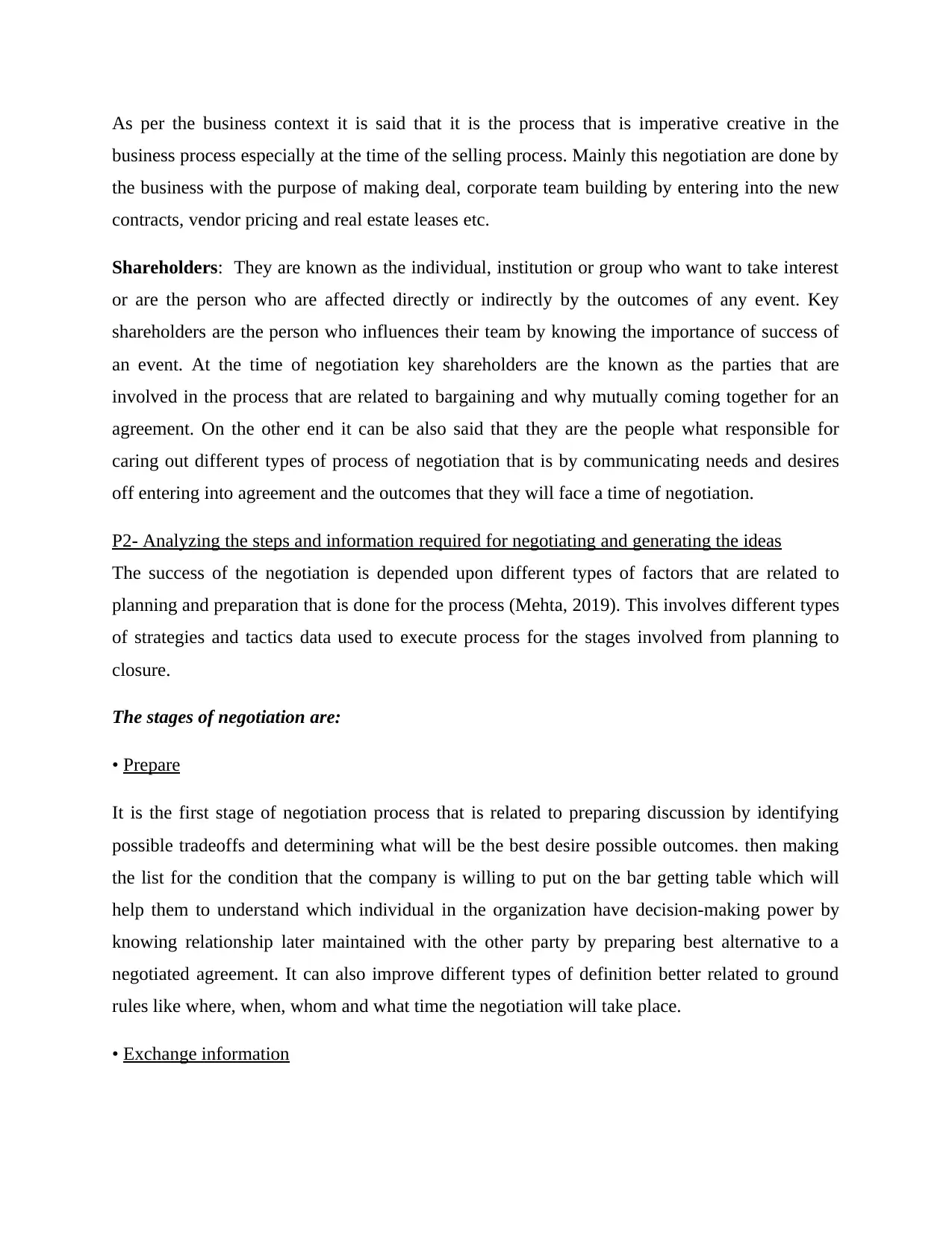
As per the business context it is said that it is the process that is imperative creative in the
business process especially at the time of the selling process. Mainly this negotiation are done by
the business with the purpose of making deal, corporate team building by entering into the new
contracts, vendor pricing and real estate leases etc.
Shareholders: They are known as the individual, institution or group who want to take interest
or are the person who are affected directly or indirectly by the outcomes of any event. Key
shareholders are the person who influences their team by knowing the importance of success of
an event. At the time of negotiation key shareholders are the known as the parties that are
involved in the process that are related to bargaining and why mutually coming together for an
agreement. On the other end it can be also said that they are the people what responsible for
caring out different types of process of negotiation that is by communicating needs and desires
off entering into agreement and the outcomes that they will face a time of negotiation.
P2- Analyzing the steps and information required for negotiating and generating the ideas
The success of the negotiation is depended upon different types of factors that are related to
planning and preparation that is done for the process (Mehta, 2019). This involves different types
of strategies and tactics data used to execute process for the stages involved from planning to
closure.
The stages of negotiation are:
• Prepare
It is the first stage of negotiation process that is related to preparing discussion by identifying
possible tradeoffs and determining what will be the best desire possible outcomes. then making
the list for the condition that the company is willing to put on the bar getting table which will
help them to understand which individual in the organization have decision-making power by
knowing relationship later maintained with the other party by preparing best alternative to a
negotiated agreement. It can also improve different types of definition better related to ground
rules like where, when, whom and what time the negotiation will take place.
• Exchange information
business process especially at the time of the selling process. Mainly this negotiation are done by
the business with the purpose of making deal, corporate team building by entering into the new
contracts, vendor pricing and real estate leases etc.
Shareholders: They are known as the individual, institution or group who want to take interest
or are the person who are affected directly or indirectly by the outcomes of any event. Key
shareholders are the person who influences their team by knowing the importance of success of
an event. At the time of negotiation key shareholders are the known as the parties that are
involved in the process that are related to bargaining and why mutually coming together for an
agreement. On the other end it can be also said that they are the people what responsible for
caring out different types of process of negotiation that is by communicating needs and desires
off entering into agreement and the outcomes that they will face a time of negotiation.
P2- Analyzing the steps and information required for negotiating and generating the ideas
The success of the negotiation is depended upon different types of factors that are related to
planning and preparation that is done for the process (Mehta, 2019). This involves different types
of strategies and tactics data used to execute process for the stages involved from planning to
closure.
The stages of negotiation are:
• Prepare
It is the first stage of negotiation process that is related to preparing discussion by identifying
possible tradeoffs and determining what will be the best desire possible outcomes. then making
the list for the condition that the company is willing to put on the bar getting table which will
help them to understand which individual in the organization have decision-making power by
knowing relationship later maintained with the other party by preparing best alternative to a
negotiated agreement. It can also improve different types of definition better related to ground
rules like where, when, whom and what time the negotiation will take place.
• Exchange information
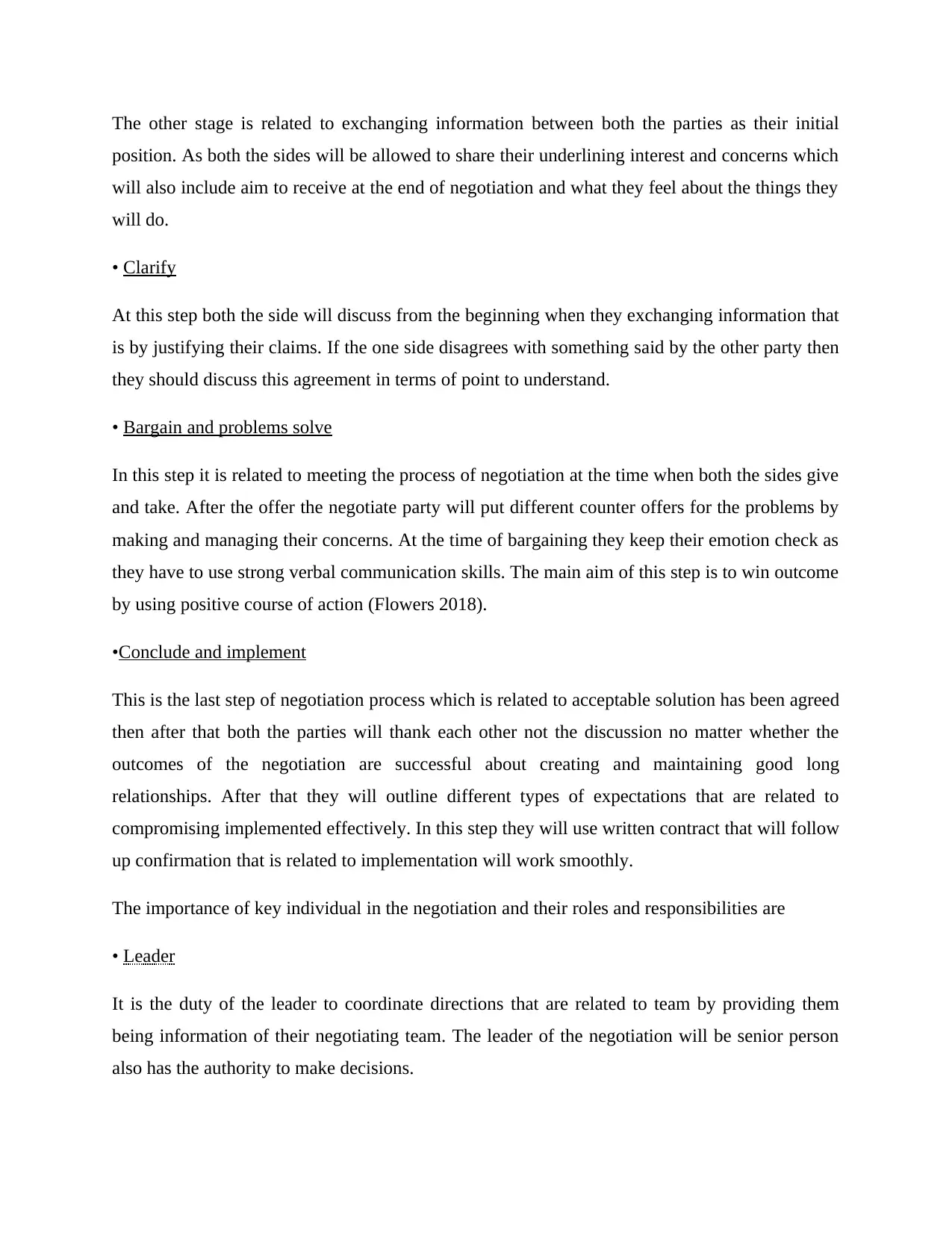
The other stage is related to exchanging information between both the parties as their initial
position. As both the sides will be allowed to share their underlining interest and concerns which
will also include aim to receive at the end of negotiation and what they feel about the things they
will do.
• Clarify
At this step both the side will discuss from the beginning when they exchanging information that
is by justifying their claims. If the one side disagrees with something said by the other party then
they should discuss this agreement in terms of point to understand.
• Bargain and problems solve
In this step it is related to meeting the process of negotiation at the time when both the sides give
and take. After the offer the negotiate party will put different counter offers for the problems by
making and managing their concerns. At the time of bargaining they keep their emotion check as
they have to use strong verbal communication skills. The main aim of this step is to win outcome
by using positive course of action (Flowers 2018).
•Conclude and implement
This is the last step of negotiation process which is related to acceptable solution has been agreed
then after that both the parties will thank each other not the discussion no matter whether the
outcomes of the negotiation are successful about creating and maintaining good long
relationships. After that they will outline different types of expectations that are related to
compromising implemented effectively. In this step they will use written contract that will follow
up confirmation that is related to implementation will work smoothly.
The importance of key individual in the negotiation and their roles and responsibilities are
• Leader
It is the duty of the leader to coordinate directions that are related to team by providing them
being information of their negotiating team. The leader of the negotiation will be senior person
also has the authority to make decisions.
position. As both the sides will be allowed to share their underlining interest and concerns which
will also include aim to receive at the end of negotiation and what they feel about the things they
will do.
• Clarify
At this step both the side will discuss from the beginning when they exchanging information that
is by justifying their claims. If the one side disagrees with something said by the other party then
they should discuss this agreement in terms of point to understand.
• Bargain and problems solve
In this step it is related to meeting the process of negotiation at the time when both the sides give
and take. After the offer the negotiate party will put different counter offers for the problems by
making and managing their concerns. At the time of bargaining they keep their emotion check as
they have to use strong verbal communication skills. The main aim of this step is to win outcome
by using positive course of action (Flowers 2018).
•Conclude and implement
This is the last step of negotiation process which is related to acceptable solution has been agreed
then after that both the parties will thank each other not the discussion no matter whether the
outcomes of the negotiation are successful about creating and maintaining good long
relationships. After that they will outline different types of expectations that are related to
compromising implemented effectively. In this step they will use written contract that will follow
up confirmation that is related to implementation will work smoothly.
The importance of key individual in the negotiation and their roles and responsibilities are
• Leader
It is the duty of the leader to coordinate directions that are related to team by providing them
being information of their negotiating team. The leader of the negotiation will be senior person
also has the authority to make decisions.
⊘ This is a preview!⊘
Do you want full access?
Subscribe today to unlock all pages.

Trusted by 1+ million students worldwide
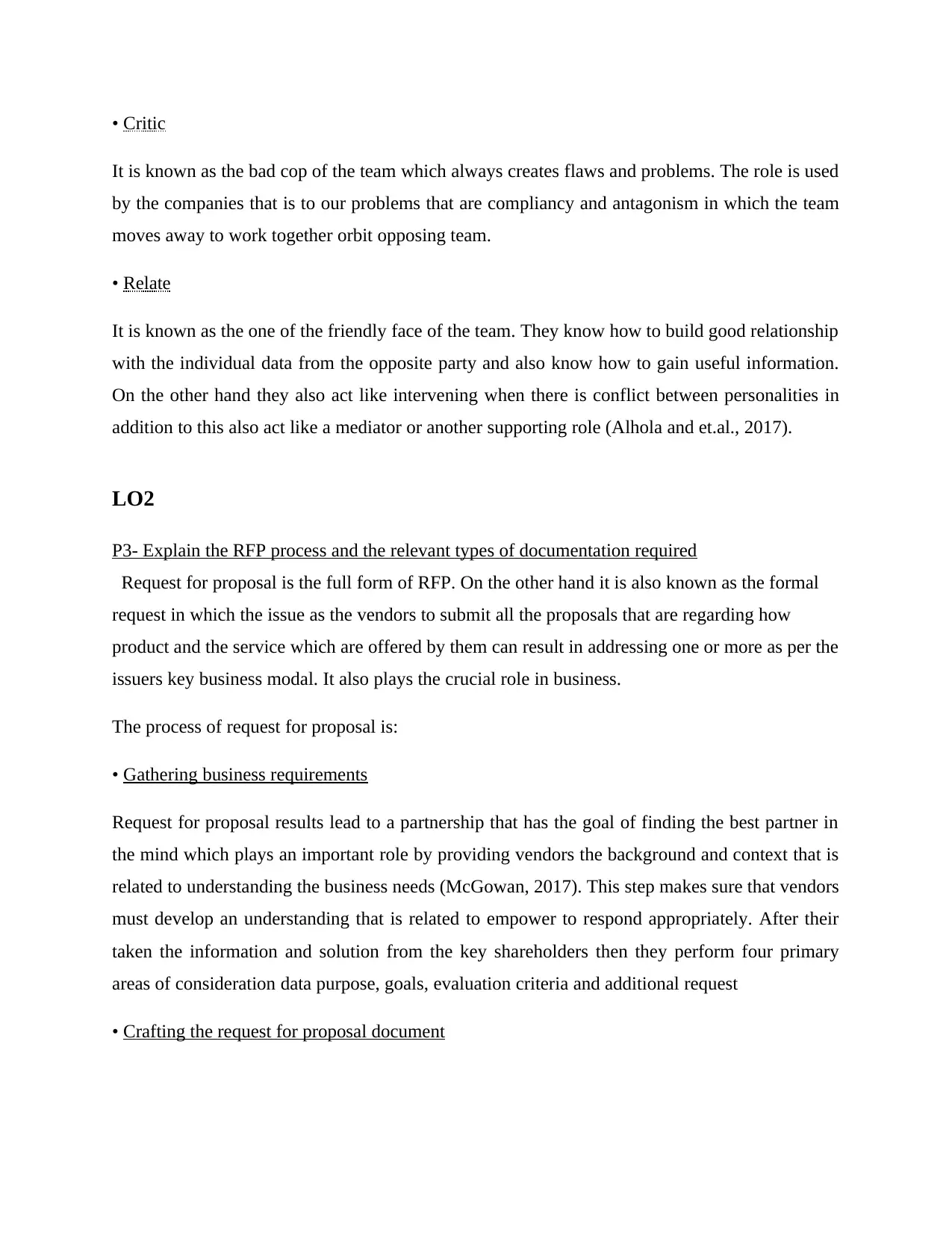
• Critic
It is known as the bad cop of the team which always creates flaws and problems. The role is used
by the companies that is to our problems that are compliancy and antagonism in which the team
moves away to work together orbit opposing team.
• Relate
It is known as the one of the friendly face of the team. They know how to build good relationship
with the individual data from the opposite party and also know how to gain useful information.
On the other hand they also act like intervening when there is conflict between personalities in
addition to this also act like a mediator or another supporting role (Alhola and et.al., 2017).
LO2
P3- Explain the RFP process and the relevant types of documentation required
Request for proposal is the full form of RFP. On the other hand it is also known as the formal
request in which the issue as the vendors to submit all the proposals that are regarding how
product and the service which are offered by them can result in addressing one or more as per the
issuers key business modal. It also plays the crucial role in business.
The process of request for proposal is:
• Gathering business requirements
Request for proposal results lead to a partnership that has the goal of finding the best partner in
the mind which plays an important role by providing vendors the background and context that is
related to understanding the business needs (McGowan, 2017). This step makes sure that vendors
must develop an understanding that is related to empower to respond appropriately. After their
taken the information and solution from the key shareholders then they perform four primary
areas of consideration data purpose, goals, evaluation criteria and additional request
• Crafting the request for proposal document
It is known as the bad cop of the team which always creates flaws and problems. The role is used
by the companies that is to our problems that are compliancy and antagonism in which the team
moves away to work together orbit opposing team.
• Relate
It is known as the one of the friendly face of the team. They know how to build good relationship
with the individual data from the opposite party and also know how to gain useful information.
On the other hand they also act like intervening when there is conflict between personalities in
addition to this also act like a mediator or another supporting role (Alhola and et.al., 2017).
LO2
P3- Explain the RFP process and the relevant types of documentation required
Request for proposal is the full form of RFP. On the other hand it is also known as the formal
request in which the issue as the vendors to submit all the proposals that are regarding how
product and the service which are offered by them can result in addressing one or more as per the
issuers key business modal. It also plays the crucial role in business.
The process of request for proposal is:
• Gathering business requirements
Request for proposal results lead to a partnership that has the goal of finding the best partner in
the mind which plays an important role by providing vendors the background and context that is
related to understanding the business needs (McGowan, 2017). This step makes sure that vendors
must develop an understanding that is related to empower to respond appropriately. After their
taken the information and solution from the key shareholders then they perform four primary
areas of consideration data purpose, goals, evaluation criteria and additional request
• Crafting the request for proposal document
Paraphrase This Document
Need a fresh take? Get an instant paraphrase of this document with our AI Paraphraser
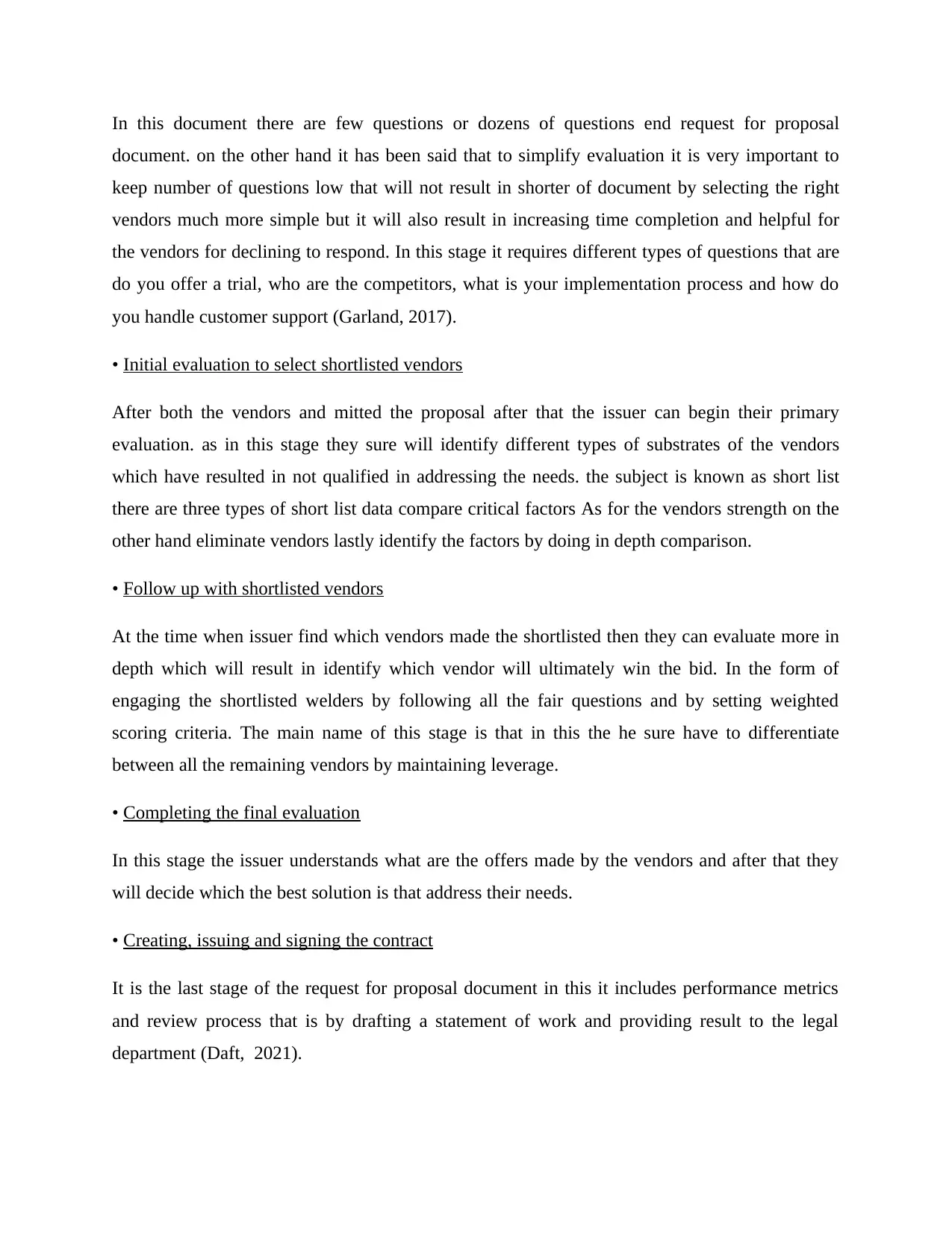
In this document there are few questions or dozens of questions end request for proposal
document. on the other hand it has been said that to simplify evaluation it is very important to
keep number of questions low that will not result in shorter of document by selecting the right
vendors much more simple but it will also result in increasing time completion and helpful for
the vendors for declining to respond. In this stage it requires different types of questions that are
do you offer a trial, who are the competitors, what is your implementation process and how do
you handle customer support (Garland, 2017).
• Initial evaluation to select shortlisted vendors
After both the vendors and mitted the proposal after that the issuer can begin their primary
evaluation. as in this stage they sure will identify different types of substrates of the vendors
which have resulted in not qualified in addressing the needs. the subject is known as short list
there are three types of short list data compare critical factors As for the vendors strength on the
other hand eliminate vendors lastly identify the factors by doing in depth comparison.
• Follow up with shortlisted vendors
At the time when issuer find which vendors made the shortlisted then they can evaluate more in
depth which will result in identify which vendor will ultimately win the bid. In the form of
engaging the shortlisted welders by following all the fair questions and by setting weighted
scoring criteria. The main name of this stage is that in this the he sure have to differentiate
between all the remaining vendors by maintaining leverage.
• Completing the final evaluation
In this stage the issuer understands what are the offers made by the vendors and after that they
will decide which the best solution is that address their needs.
• Creating, issuing and signing the contract
It is the last stage of the request for proposal document in this it includes performance metrics
and review process that is by drafting a statement of work and providing result to the legal
department (Daft, 2021).
document. on the other hand it has been said that to simplify evaluation it is very important to
keep number of questions low that will not result in shorter of document by selecting the right
vendors much more simple but it will also result in increasing time completion and helpful for
the vendors for declining to respond. In this stage it requires different types of questions that are
do you offer a trial, who are the competitors, what is your implementation process and how do
you handle customer support (Garland, 2017).
• Initial evaluation to select shortlisted vendors
After both the vendors and mitted the proposal after that the issuer can begin their primary
evaluation. as in this stage they sure will identify different types of substrates of the vendors
which have resulted in not qualified in addressing the needs. the subject is known as short list
there are three types of short list data compare critical factors As for the vendors strength on the
other hand eliminate vendors lastly identify the factors by doing in depth comparison.
• Follow up with shortlisted vendors
At the time when issuer find which vendors made the shortlisted then they can evaluate more in
depth which will result in identify which vendor will ultimately win the bid. In the form of
engaging the shortlisted welders by following all the fair questions and by setting weighted
scoring criteria. The main name of this stage is that in this the he sure have to differentiate
between all the remaining vendors by maintaining leverage.
• Completing the final evaluation
In this stage the issuer understands what are the offers made by the vendors and after that they
will decide which the best solution is that address their needs.
• Creating, issuing and signing the contract
It is the last stage of the request for proposal document in this it includes performance metrics
and review process that is by drafting a statement of work and providing result to the legal
department (Daft, 2021).
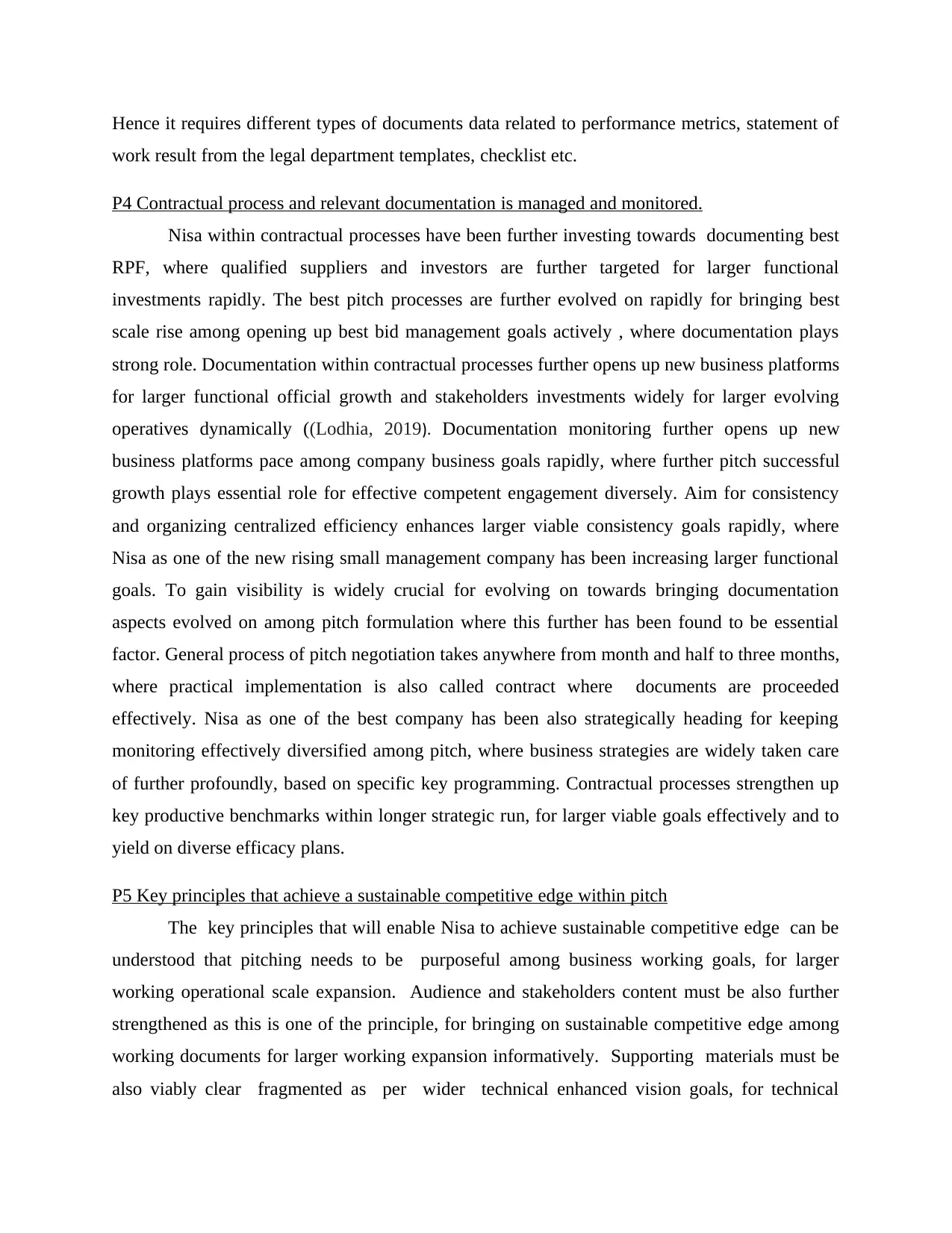
Hence it requires different types of documents data related to performance metrics, statement of
work result from the legal department templates, checklist etc.
P4 Contractual process and relevant documentation is managed and monitored.
Nisa within contractual processes have been further investing towards documenting best
RPF, where qualified suppliers and investors are further targeted for larger functional
investments rapidly. The best pitch processes are further evolved on rapidly for bringing best
scale rise among opening up best bid management goals actively , where documentation plays
strong role. Documentation within contractual processes further opens up new business platforms
for larger functional official growth and stakeholders investments widely for larger evolving
operatives dynamically ((Lodhia, 2019). Documentation monitoring further opens up new
business platforms pace among company business goals rapidly, where further pitch successful
growth plays essential role for effective competent engagement diversely. Aim for consistency
and organizing centralized efficiency enhances larger viable consistency goals rapidly, where
Nisa as one of the new rising small management company has been increasing larger functional
goals. To gain visibility is widely crucial for evolving on towards bringing documentation
aspects evolved on among pitch formulation where this further has been found to be essential
factor. General process of pitch negotiation takes anywhere from month and half to three months,
where practical implementation is also called contract where documents are proceeded
effectively. Nisa as one of the best company has been also strategically heading for keeping
monitoring effectively diversified among pitch, where business strategies are widely taken care
of further profoundly, based on specific key programming. Contractual processes strengthen up
key productive benchmarks within longer strategic run, for larger viable goals effectively and to
yield on diverse efficacy plans.
P5 Key principles that achieve a sustainable competitive edge within pitch
The key principles that will enable Nisa to achieve sustainable competitive edge can be
understood that pitching needs to be purposeful among business working goals, for larger
working operational scale expansion. Audience and stakeholders content must be also further
strengthened as this is one of the principle, for bringing on sustainable competitive edge among
working documents for larger working expansion informatively. Supporting materials must be
also viably clear fragmented as per wider technical enhanced vision goals, for technical
work result from the legal department templates, checklist etc.
P4 Contractual process and relevant documentation is managed and monitored.
Nisa within contractual processes have been further investing towards documenting best
RPF, where qualified suppliers and investors are further targeted for larger functional
investments rapidly. The best pitch processes are further evolved on rapidly for bringing best
scale rise among opening up best bid management goals actively , where documentation plays
strong role. Documentation within contractual processes further opens up new business platforms
for larger functional official growth and stakeholders investments widely for larger evolving
operatives dynamically ((Lodhia, 2019). Documentation monitoring further opens up new
business platforms pace among company business goals rapidly, where further pitch successful
growth plays essential role for effective competent engagement diversely. Aim for consistency
and organizing centralized efficiency enhances larger viable consistency goals rapidly, where
Nisa as one of the new rising small management company has been increasing larger functional
goals. To gain visibility is widely crucial for evolving on towards bringing documentation
aspects evolved on among pitch formulation where this further has been found to be essential
factor. General process of pitch negotiation takes anywhere from month and half to three months,
where practical implementation is also called contract where documents are proceeded
effectively. Nisa as one of the best company has been also strategically heading for keeping
monitoring effectively diversified among pitch, where business strategies are widely taken care
of further profoundly, based on specific key programming. Contractual processes strengthen up
key productive benchmarks within longer strategic run, for larger viable goals effectively and to
yield on diverse efficacy plans.
P5 Key principles that achieve a sustainable competitive edge within pitch
The key principles that will enable Nisa to achieve sustainable competitive edge can be
understood that pitching needs to be purposeful among business working goals, for larger
working operational scale expansion. Audience and stakeholders content must be also further
strengthened as this is one of the principle, for bringing on sustainable competitive edge among
working documents for larger working expansion informatively. Supporting materials must be
also viably clear fragmented as per wider technical enhanced vision goals, for technical
⊘ This is a preview!⊘
Do you want full access?
Subscribe today to unlock all pages.

Trusted by 1+ million students worldwide
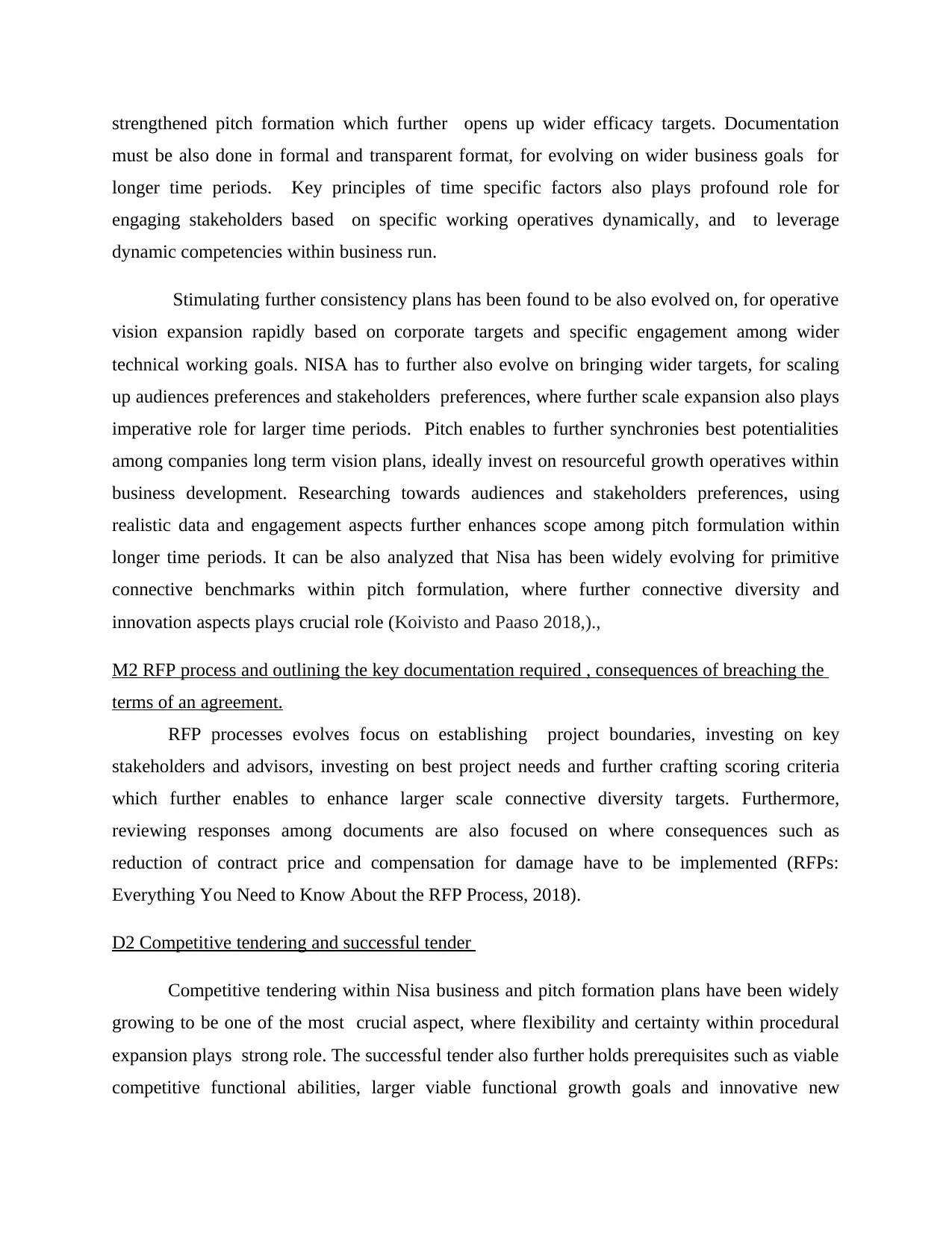
strengthened pitch formation which further opens up wider efficacy targets. Documentation
must be also done in formal and transparent format, for evolving on wider business goals for
longer time periods. Key principles of time specific factors also plays profound role for
engaging stakeholders based on specific working operatives dynamically, and to leverage
dynamic competencies within business run.
Stimulating further consistency plans has been found to be also evolved on, for operative
vision expansion rapidly based on corporate targets and specific engagement among wider
technical working goals. NISA has to further also evolve on bringing wider targets, for scaling
up audiences preferences and stakeholders preferences, where further scale expansion also plays
imperative role for larger time periods. Pitch enables to further synchronies best potentialities
among companies long term vision plans, ideally invest on resourceful growth operatives within
business development. Researching towards audiences and stakeholders preferences, using
realistic data and engagement aspects further enhances scope among pitch formulation within
longer time periods. It can be also analyzed that Nisa has been widely evolving for primitive
connective benchmarks within pitch formulation, where further connective diversity and
innovation aspects plays crucial role (Koivisto and Paaso 2018,).,
M2 RFP process and outlining the key documentation required , consequences of breaching the
terms of an agreement.
RFP processes evolves focus on establishing project boundaries, investing on key
stakeholders and advisors, investing on best project needs and further crafting scoring criteria
which further enables to enhance larger scale connective diversity targets. Furthermore,
reviewing responses among documents are also focused on where consequences such as
reduction of contract price and compensation for damage have to be implemented (RFPs:
Everything You Need to Know About the RFP Process, 2018).
D2 Competitive tendering and successful tender
Competitive tendering within Nisa business and pitch formation plans have been widely
growing to be one of the most crucial aspect, where flexibility and certainty within procedural
expansion plays strong role. The successful tender also further holds prerequisites such as viable
competitive functional abilities, larger viable functional growth goals and innovative new
must be also done in formal and transparent format, for evolving on wider business goals for
longer time periods. Key principles of time specific factors also plays profound role for
engaging stakeholders based on specific working operatives dynamically, and to leverage
dynamic competencies within business run.
Stimulating further consistency plans has been found to be also evolved on, for operative
vision expansion rapidly based on corporate targets and specific engagement among wider
technical working goals. NISA has to further also evolve on bringing wider targets, for scaling
up audiences preferences and stakeholders preferences, where further scale expansion also plays
imperative role for larger time periods. Pitch enables to further synchronies best potentialities
among companies long term vision plans, ideally invest on resourceful growth operatives within
business development. Researching towards audiences and stakeholders preferences, using
realistic data and engagement aspects further enhances scope among pitch formulation within
longer time periods. It can be also analyzed that Nisa has been widely evolving for primitive
connective benchmarks within pitch formulation, where further connective diversity and
innovation aspects plays crucial role (Koivisto and Paaso 2018,).,
M2 RFP process and outlining the key documentation required , consequences of breaching the
terms of an agreement.
RFP processes evolves focus on establishing project boundaries, investing on key
stakeholders and advisors, investing on best project needs and further crafting scoring criteria
which further enables to enhance larger scale connective diversity targets. Furthermore,
reviewing responses among documents are also focused on where consequences such as
reduction of contract price and compensation for damage have to be implemented (RFPs:
Everything You Need to Know About the RFP Process, 2018).
D2 Competitive tendering and successful tender
Competitive tendering within Nisa business and pitch formation plans have been widely
growing to be one of the most crucial aspect, where flexibility and certainty within procedural
expansion plays strong role. The successful tender also further holds prerequisites such as viable
competitive functional abilities, larger viable functional growth goals and innovative new
Paraphrase This Document
Need a fresh take? Get an instant paraphrase of this document with our AI Paraphraser
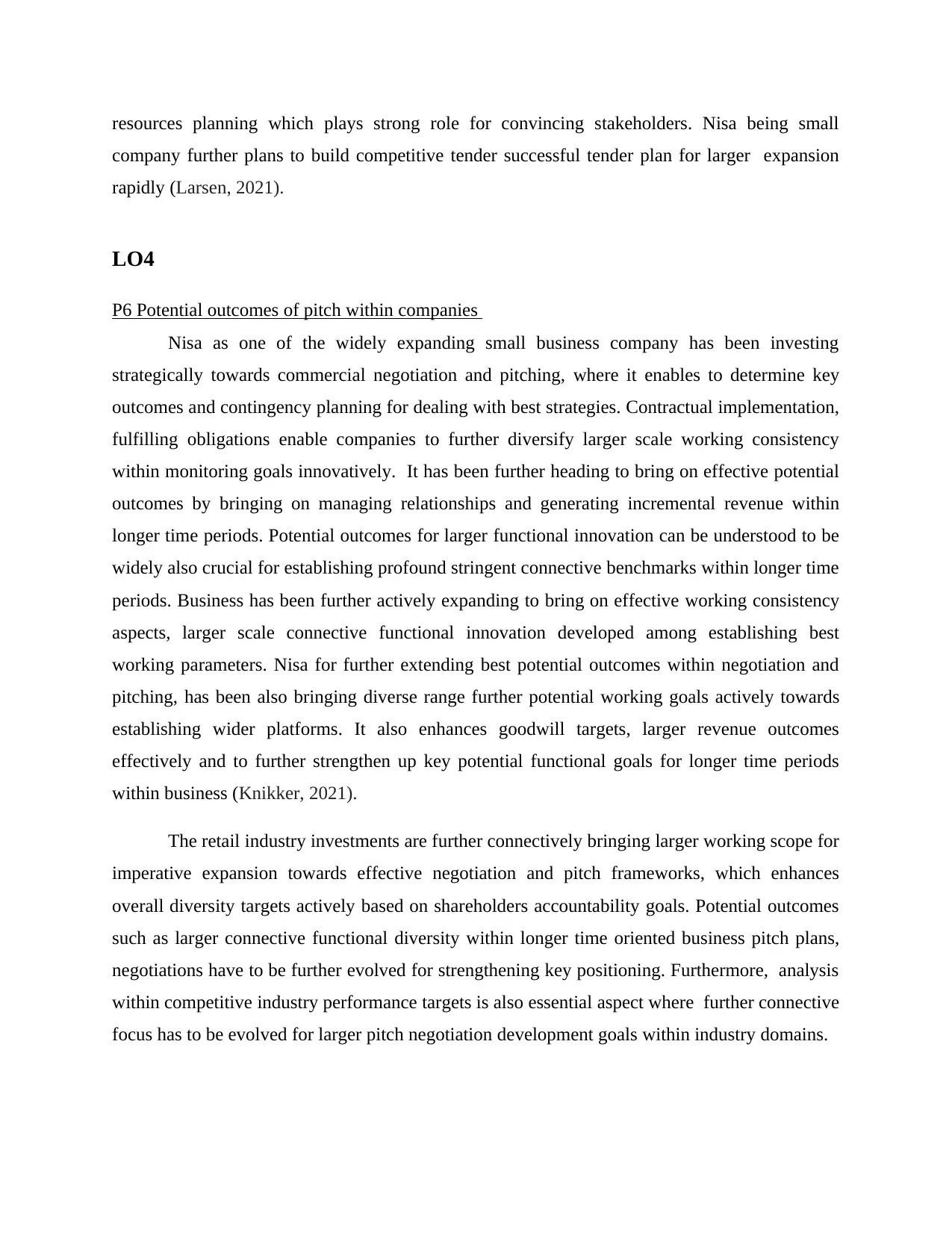
resources planning which plays strong role for convincing stakeholders. Nisa being small
company further plans to build competitive tender successful tender plan for larger expansion
rapidly (Larsen, 2021).
LO4
P6 Potential outcomes of pitch within companies
Nisa as one of the widely expanding small business company has been investing
strategically towards commercial negotiation and pitching, where it enables to determine key
outcomes and contingency planning for dealing with best strategies. Contractual implementation,
fulfilling obligations enable companies to further diversify larger scale working consistency
within monitoring goals innovatively. It has been further heading to bring on effective potential
outcomes by bringing on managing relationships and generating incremental revenue within
longer time periods. Potential outcomes for larger functional innovation can be understood to be
widely also crucial for establishing profound stringent connective benchmarks within longer time
periods. Business has been further actively expanding to bring on effective working consistency
aspects, larger scale connective functional innovation developed among establishing best
working parameters. Nisa for further extending best potential outcomes within negotiation and
pitching, has been also bringing diverse range further potential working goals actively towards
establishing wider platforms. It also enhances goodwill targets, larger revenue outcomes
effectively and to further strengthen up key potential functional goals for longer time periods
within business (Knikker, 2021).
The retail industry investments are further connectively bringing larger working scope for
imperative expansion towards effective negotiation and pitch frameworks, which enhances
overall diversity targets actively based on shareholders accountability goals. Potential outcomes
such as larger connective functional diversity within longer time oriented business pitch plans,
negotiations have to be further evolved for strengthening key positioning. Furthermore, analysis
within competitive industry performance targets is also essential aspect where further connective
focus has to be evolved for larger pitch negotiation development goals within industry domains.
company further plans to build competitive tender successful tender plan for larger expansion
rapidly (Larsen, 2021).
LO4
P6 Potential outcomes of pitch within companies
Nisa as one of the widely expanding small business company has been investing
strategically towards commercial negotiation and pitching, where it enables to determine key
outcomes and contingency planning for dealing with best strategies. Contractual implementation,
fulfilling obligations enable companies to further diversify larger scale working consistency
within monitoring goals innovatively. It has been further heading to bring on effective potential
outcomes by bringing on managing relationships and generating incremental revenue within
longer time periods. Potential outcomes for larger functional innovation can be understood to be
widely also crucial for establishing profound stringent connective benchmarks within longer time
periods. Business has been further actively expanding to bring on effective working consistency
aspects, larger scale connective functional innovation developed among establishing best
working parameters. Nisa for further extending best potential outcomes within negotiation and
pitching, has been also bringing diverse range further potential working goals actively towards
establishing wider platforms. It also enhances goodwill targets, larger revenue outcomes
effectively and to further strengthen up key potential functional goals for longer time periods
within business (Knikker, 2021).
The retail industry investments are further connectively bringing larger working scope for
imperative expansion towards effective negotiation and pitch frameworks, which enhances
overall diversity targets actively based on shareholders accountability goals. Potential outcomes
such as larger connective functional diversity within longer time oriented business pitch plans,
negotiations have to be further evolved for strengthening key positioning. Furthermore, analysis
within competitive industry performance targets is also essential aspect where further connective
focus has to be evolved for larger pitch negotiation development goals within industry domains.
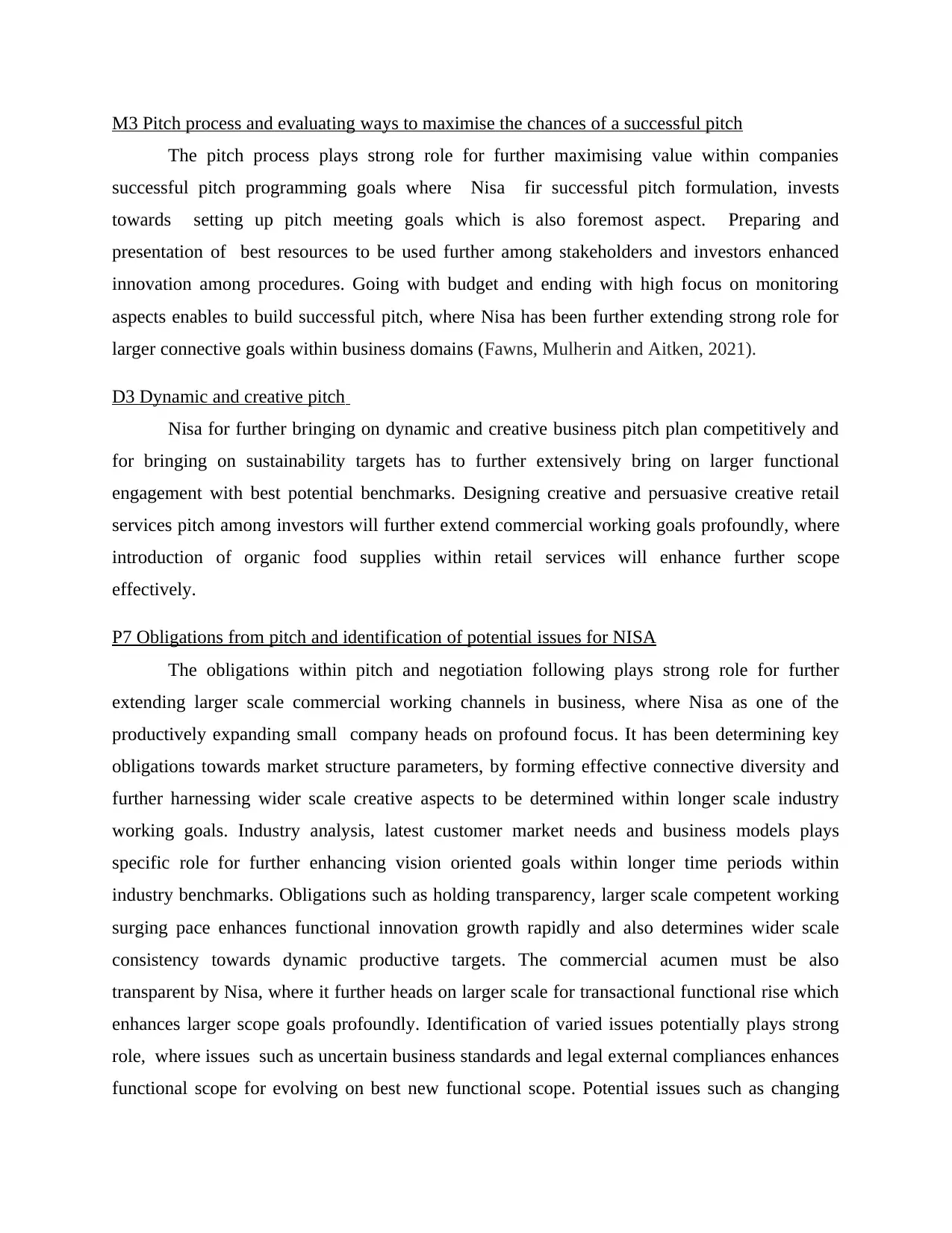
M3 Pitch process and evaluating ways to maximise the chances of a successful pitch
The pitch process plays strong role for further maximising value within companies
successful pitch programming goals where Nisa fir successful pitch formulation, invests
towards setting up pitch meeting goals which is also foremost aspect. Preparing and
presentation of best resources to be used further among stakeholders and investors enhanced
innovation among procedures. Going with budget and ending with high focus on monitoring
aspects enables to build successful pitch, where Nisa has been further extending strong role for
larger connective goals within business domains (Fawns, Mulherin and Aitken, 2021).
D3 Dynamic and creative pitch
Nisa for further bringing on dynamic and creative business pitch plan competitively and
for bringing on sustainability targets has to further extensively bring on larger functional
engagement with best potential benchmarks. Designing creative and persuasive creative retail
services pitch among investors will further extend commercial working goals profoundly, where
introduction of organic food supplies within retail services will enhance further scope
effectively.
P7 Obligations from pitch and identification of potential issues for NISA
The obligations within pitch and negotiation following plays strong role for further
extending larger scale commercial working channels in business, where Nisa as one of the
productively expanding small company heads on profound focus. It has been determining key
obligations towards market structure parameters, by forming effective connective diversity and
further harnessing wider scale creative aspects to be determined within longer scale industry
working goals. Industry analysis, latest customer market needs and business models plays
specific role for further enhancing vision oriented goals within longer time periods within
industry benchmarks. Obligations such as holding transparency, larger scale competent working
surging pace enhances functional innovation growth rapidly and also determines wider scale
consistency towards dynamic productive targets. The commercial acumen must be also
transparent by Nisa, where it further heads on larger scale for transactional functional rise which
enhances larger scope goals profoundly. Identification of varied issues potentially plays strong
role, where issues such as uncertain business standards and legal external compliances enhances
functional scope for evolving on best new functional scope. Potential issues such as changing
The pitch process plays strong role for further maximising value within companies
successful pitch programming goals where Nisa fir successful pitch formulation, invests
towards setting up pitch meeting goals which is also foremost aspect. Preparing and
presentation of best resources to be used further among stakeholders and investors enhanced
innovation among procedures. Going with budget and ending with high focus on monitoring
aspects enables to build successful pitch, where Nisa has been further extending strong role for
larger connective goals within business domains (Fawns, Mulherin and Aitken, 2021).
D3 Dynamic and creative pitch
Nisa for further bringing on dynamic and creative business pitch plan competitively and
for bringing on sustainability targets has to further extensively bring on larger functional
engagement with best potential benchmarks. Designing creative and persuasive creative retail
services pitch among investors will further extend commercial working goals profoundly, where
introduction of organic food supplies within retail services will enhance further scope
effectively.
P7 Obligations from pitch and identification of potential issues for NISA
The obligations within pitch and negotiation following plays strong role for further
extending larger scale commercial working channels in business, where Nisa as one of the
productively expanding small company heads on profound focus. It has been determining key
obligations towards market structure parameters, by forming effective connective diversity and
further harnessing wider scale creative aspects to be determined within longer scale industry
working goals. Industry analysis, latest customer market needs and business models plays
specific role for further enhancing vision oriented goals within longer time periods within
industry benchmarks. Obligations such as holding transparency, larger scale competent working
surging pace enhances functional innovation growth rapidly and also determines wider scale
consistency towards dynamic productive targets. The commercial acumen must be also
transparent by Nisa, where it further heads on larger scale for transactional functional rise which
enhances larger scope goals profoundly. Identification of varied issues potentially plays strong
role, where issues such as uncertain business standards and legal external compliances enhances
functional scope for evolving on best new functional scope. Potential issues such as changing
⊘ This is a preview!⊘
Do you want full access?
Subscribe today to unlock all pages.

Trusted by 1+ million students worldwide
1 out of 16
Related Documents
Your All-in-One AI-Powered Toolkit for Academic Success.
+13062052269
info@desklib.com
Available 24*7 on WhatsApp / Email
![[object Object]](/_next/static/media/star-bottom.7253800d.svg)
Unlock your academic potential
Copyright © 2020–2025 A2Z Services. All Rights Reserved. Developed and managed by ZUCOL.


